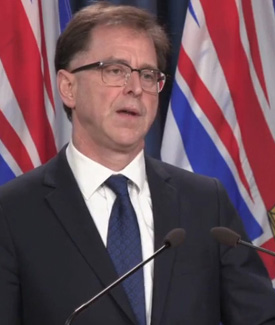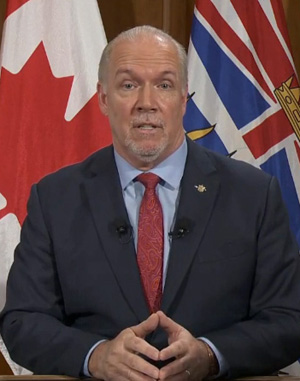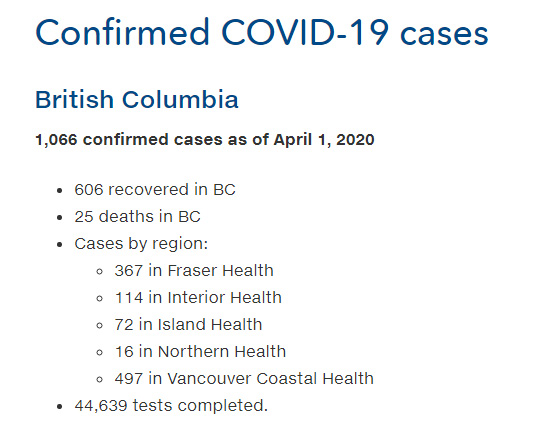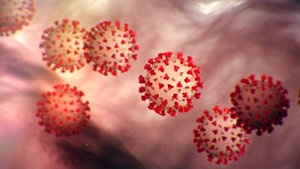Wednesday April 1, 2020 ~ VANCOUVER
by Mary Brooke, B.Sc. ~ West Shore Voice News
Today’s daily COVID-19 media briefing by BC Health Minister Adrian Dix and Provincial Health Officer Dr Bonnie Henry was long on words and less busy with detail.
It felt a bit like the calm before the storm, but it also felt like an attempt at distraction, with unsuitably long answers to questions that ate up time for more pointed inquiries by hard-working media who are now attending several teleconferences a day about COVID-19.
Yesterday Dr Henry was quite articulate about this week being a point in time where the first round of results of self-isolation and physical distancing efforts will be seen. If the strategy to isolate and separate has been effective, there will not be as huge a surge in cases to hospital compared to what would probably happen under unmitigated conditions.
The whole idea has been to slow down the rate of active cases that require hospitalization, a process we’ve all rapidly come to know in the public health lingo as ‘flattening the curve’.
Today Dr Henry reported 1,066 confirmed cases (up from 1,013 yesterday), of which 606 have recovered. Presently there are 142 people with confirmed COVID-19 infection in hospital, with 67 of those in intensive care.

Across the province, now 19 primary hospital sites are preparing or prepared for treating patients with COVID-19; in all there are now 4,192 empty beds for acute care, many of those freed up by having cancelled elective surgeries back on March 16.
Hospitals are operating at 61% of capacity in the acute care system (allowing room for more patients), with 55.5% of critical care beds being occupied right now.
As BC Provincial Health Officer Dr Bonnie Henry has been telling British Columbians, not everyone presents with severe symptoms of the disease, articulating that elderly people (generally over age 65 or 70), people with underlying health conditions and people who are immuno-challenged will have a tougher time of it.
There is no treatment, cure or vaccine for counteracting the COVID-19 coronavirus at this time. Best hope for a vaccine is likely by the fall of 2021, based on the usual timelines required for development and testing of a new vaccine.
Dr Henry and Health Minister Adrian Dix have been saying for weeks that they need everyone to be “100% all in” with regards to self-isolation and physical distancing. Yesterday evening in a live address broadcast widely on TV, radio and social media Premier John Horgan appealed urgently for everyone “to take this very seriously… these are not suggestions, they’re the law”.
This afternoon April 1 in their 3 pm livestreamed media session, Dr Henry and Dix presented the day’s COVID-19 confirmed case stats, matter of factly reported on the number of hospitalized cases, and the number of deaths. If this is now an escalating war against a deadly virus, the dry start of these joint media conferences seems somehow not quite enough. Time for a little more speech-writing flair.
Though with some urgency, Dr Henry did say on March 30: “This is it. This is our watershed, these coming weeks. We will flatten that curve no matter how long it takes. This is our week to reinforce our effort. To do our part together while we’re staying apart.” The incubation period for COVID-19 infection is thought to be 14 days.
Minister Dix today again thanked health care workers, as well as grocery store workers and truckers for maintaining food and supplies. These underpinnings of our economy carry on, like a subterranean level of productivity in support of people self-isolating.
Again this evening at 7 pm there was clapping and the ‘banging of pots and pans’ in communities around the province, in support of health care workers.
RETURNING FROM TRAVEL

The federal requirement that travellers from outside the country go straight home to 14 days of self isolation is different from just a few weeks ago when entire airplanes filled with returning travellers were placed in government-supported quarantine facilities.
Dix said today April 1 that he hopes the federal government is doing their best to inform travellers who arrive at YVR Airport in Vancouver about that regulation.
The health minister called it “a betrayal of the people in your community to not follow those rules”. He pointed out that going directly home and staying home for 14 days is the law at the federal level and an order at the provincial level.
STILL AN UNKNOWN TRAJECTORY
Dix said there are “very difficult weeks” ahead. “All British Columbians need to recommit to doing our part. Stay with this. We can’t stop now. Today and every day – in BC the task is simple. Dig deeper, work harder, be all in,” the Health Minister said. A lot of people have made a lot of sacrifices to jobs, family life, activities and overall stability to take part in the requests of public health officials to stay home during the pandemic.
DELIVERING THE MESSAGE WITH APPROPRIATE INTENSITY
Overall, politicians are indicating that there is still not full compliance of the population with the orders to self-isolate at home and to physically distance. It’s possible that early messaging that COVID-19 was a disease mostly affecting seniors and the elderly gave room for younger adults to tune out the inevitable reality of community spread.

Public health officials might need to do more than ask for “100% all in”. People are ready to heard some more specific compelling reasons. More graphic description of the specifics of the disease — without being gory — might help. The painting visual images of how families are impacted when someone dies suddenly from a brand new virus might be more fully made. There’s a skillful way to do that with inciting fear. The goal is elevate a sense of heightened responsiveness.
Tact and persuasion are appropriate and desirable in governance most of the time. But if we’re being told this is extremely serious (as freeing up over 4,000 beds and declaring a state of emergency — including control of the supply chain — would imply), then the delivery of the message needs to now line up with its dire content.
People don’t want to be sweet-talked if there’s figuratively a fire right outside the front door. British Columbians are educated, attentive and ready to fight. For some reason, the words of public health officials and political leaders are there, but without now a fiery tone. The urgency of this juncture ahead of broader community spread now requires more alignment of words with tone.
Though to be fair, look how much has changed and so drastically in just a matter of weeks. Asking people to turn their lives upside down and essentially abandon huge components of normal social life and liberties of movement is a shock not yet fully absorbed. Politicians are treading lightly.

The stressed look on Premier John Horgan’s face last night in his televised address about COVID-19 is what people needed to see. This is not in any way politics as usual. The generally unflappable premier has no doubt seen statistical projections of COVID-19 infection spread and is aware of the gravity of the measures being imposed on a the peaceful community of British Columbians.
Our province has been essentially dismantled to the bone, bringing the economy to its knees. People are somewhat traumatized by what has been asked of them. Sometimes people need to hear some blunt words; there isn’t enough energy to process subtle talk now. Real facts put containment around fear.
People are tense, yes. But holding back on some more authentic messaging is probably not going to be helpful for too much longer. Without a match-up of content and delivery, that’s why we’re still seeing people messing up around the edges of full compliance to self-isolation and social distancing.
CONFIRMED CASES OF COVID-19 at APRIL 1:

As of today April 1, there are 1,066 confirmed cases of COVID-19 in BC (up from 1,013 yesterday), of which 606 have recovered but 25 have died. Cases by region: 497 in Vancouver Coastal Health, 367 in Fraser Health, 114 in Interior Health, 72 in Island Health, and 16 in Northern Health. To date, 44,639 tests have been completed. Today’s statistics (April 1, 2020) from the BC Centre for Disease Control.



